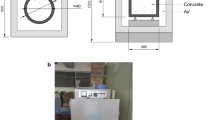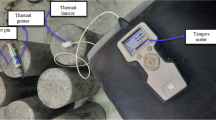Abstract
In order to compare the compensation effect of expansive materials with different mineral sources on the temperature stress of concrete, we investigated the temperature stress of concrete when adding calcium sulfoaluminate type expansive materials (CSA) or CaO and calcium sulfoaluminate mixed type expansive materials (HCSA) at different temperatures by temperature-stress testing machine (TSTM) considering the influence of temperature history on the expansion. The experimental results show that the expansion characteristics of the two kinds of expansive materials with different mineral sources significantly vary. When adding expansive materials, the growth rate of compressive stress during the heating stage increases obviously, the maximum compressive stress is higher, while the decline rate of tensile stress in the late cooling stage becomes slow, and finally cracking temperature decreases. It is proved that concrete with HCSA has lower cracking temperatures and better temperature shrinkage compensation effect. Therefore, it is rational to choose HCSA when preparing concrete with high expansion energy to reduce thermal cracking.
Similar content being viewed by others
References
Springenschmid R. Thermal Cracking in Concrete at Early Ages[C]. Munich, 1994: Xi–Xii
Springenschmid R. Avoidance of Thermal Cracking in Concrete at Early Ages[C]. Munich: E&FN SPON, 1998
Breitenbucher R, Mangold M. Minimization of Thermal Cracking in Concrete Members at Early Ages[M]. Munich: E&FN SPON, 1994: 205–212
Springenschmid R, Breitenbucher R. Influence of Constituents, Mix Proportion and Temperature on Cracking Sensitivity of Concrete[A]. Avoidance of Thermal Cracking in Concrete at Early Ages[C]. Munich, 1998: 40–50
GB/T 23439-2017, Expensive agents for concrete[S]. Chinese Standard Press, 2017
Mehta PK. Expansion Characteristics of Calcium Sulfoaluminate Hydrates[J]. J. Am. Ceram. Soc., 1967, 50(4): 204–208
Mehta PK. Mechanism of Expansion Associated with Ettringite Formation[J]. Cem. Concr. Res., 1973, 3(1): 1–6
Ogawa K, Roy DM. C4A3 Hydration Ettringite Formation, and Its Expansion Mechanism: I. Expansion; Ettringite Stability[J]. Cem. Concr. Res., 1981, 11(5/6): 741–750
Ogawa K, Roy DM. C4A3 Hydration, Ettringite Formation, and Its Expansion Mechanism: II. Microstructural Observation of Expansion[J]. Cem. Concr. Res., 1982, 12(1): 101–109
Ish-Shalom M, Bentur A. Properties of Type K Expansive Cement of Pure Components I. Hydration of Unrestrained Paste of Expansive Component-Results[J]. Cem. Concr. Res., 1974, 4(4): 519–532
Bentur A, Ish-Shalom M. Properties of Type K Expensive Cement of Pure Components II. Proposed Mechanism of Ettringite Formation and Expansion in Unrestrained Paste of Pure Expansive Component[J]. Cem. Concr. Res., 1974, 4(5): 709–721
Mind, Tang MS. Formation and Expansion of Ettringite Crystals[J]. Cem. Concr. Res., 1994, 24(1): 119–126
Zhao SZ, You BK. Cracking Control Technology and Its Application of Shrinkage-Compensated Concrete[M]. China Construction Industry Press, 2010
Han JG, Yan PY, Hou WH. Expansion Character of C4A3-CaSO4-CaO System in Portland Cement Paste[J]. Journal of the Chinese Ceramic Society, 2016, 44(8):1120–1125
Han JG, Yan PY, Hou WH. Expansion Mechanism of C4A3−CaSO4−CaO in Portland Cement Paste [J]. Journal of the Chinese Ceramic Society, 2016, 44(11): 1543–1551
Mizobuchi T. Discussion on The Experimental Evaluation of Reducing Effect of Thermal Stress of Expansive Additive Based on Uniaxial Restraint Testing Device[J]. JCI Conference, Japanese, 1998: 1051–1056
Springenchmid R, Gierlinger E, Kiernozycki W. Thermal Stress in Mass Concrete: A New Testing Method and the Influence of Different Cement[C]//15th Congress on Large Dams, Lausanne, Switzerland, 1985: 57–72
Maruyama I, Park SG, Takafumi N. Time-Dependent Mechanical Properties of Concrete under Simulated Complete Restrained at Early Age[J]. Proc. J. Concr. Instit., 2002, 24(1): 357–362
Park SG, Maruyama I, Kim JJ, et al. Mechanical Properties of Expansive High-Strength Concrete under Simulated-Completely Restrained Condition at Early Age[C]//The Ninth East Asia-Pacific Conference on Structural Engineering and Construction: 56–61
RILEM TC 119-TCE. Avoidance of Thermal Cracking in Concrete at Early Ages[J]. Materials and Structures, 1997(30): 461–464
Riding KA, Poole JL, Schindler A K, et al. Quantification of Effects of Fly Ash Type on Concrete Early-age Cracking[J]. ACI Materials Journal, 2008, 105(2): 149–155
Yan PY, Chen GZ. Impact of Curing Temperature And Gelling Material Composition to Restricted Expansion Rate of Expansion Agent[J]. Architecture Technology, 2001(1): 22–23
Yan PY, Zheng F. Influence of Temperature on The Hydration Heat Evolution of Shrink-Age-Compensating Complex Binders[J]. Journal of the Chinese Ceramic Society, 2006, 8(8):1006–1010
Feng JJ, Miao M, Yan PY. The Effect of Curing Temperature on the Properties of Shrinkage-Compensated Binder[J]. Sci. China Tech. Sci., 2011, 54: 869–875
Ding JT, Chen B, Cai YB, et al. Influence of Temperature History on Crack Resistance of Early Age Concrete+[J]. Jiangsu Univ.: Nat. Sci. Ed., 2010, 32(2): 236–240 (in Chinese)
Funding
Funded by the National Key R&D Program of China (2017YFB0310102)
Author information
Authors and Affiliations
Corresponding author
Rights and permissions
About this article
Cite this article
Jia, F., Yao, Y., Zhao, S. et al. Experimental Study on Thermal Stress of Concrete with Different Expansive Minerals Using a Temperature Stress Testing Machine. J. Wuhan Univ. Technol.-Mat. Sci. Edit. 37, 222–228 (2022). https://doi.org/10.1007/s11595-022-2521-3
Received:
Accepted:
Published:
Issue Date:
DOI: https://doi.org/10.1007/s11595-022-2521-3




